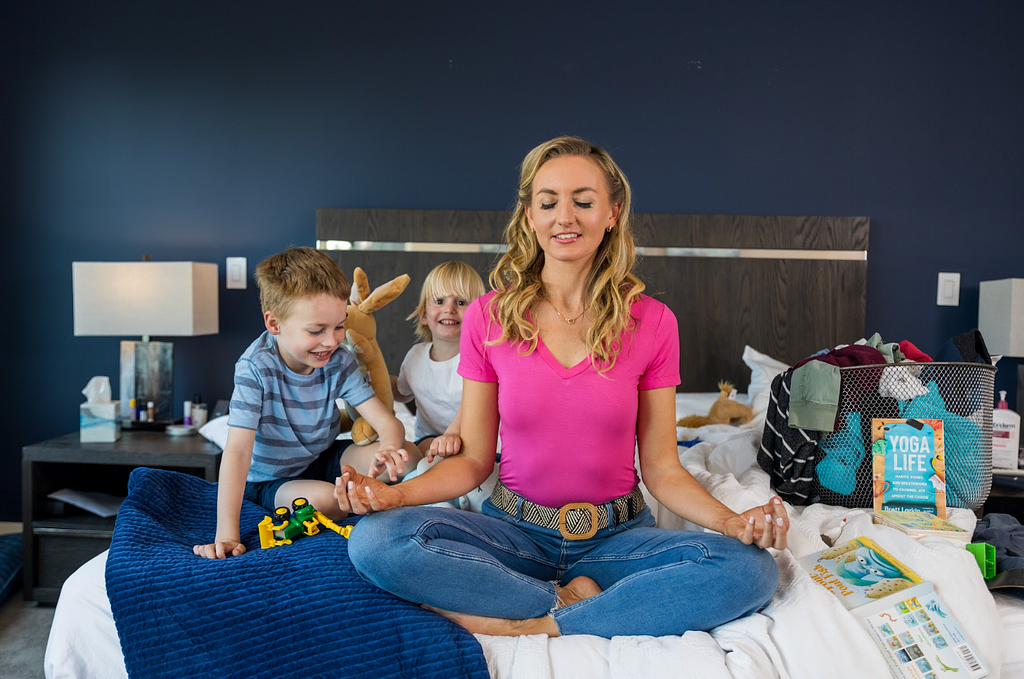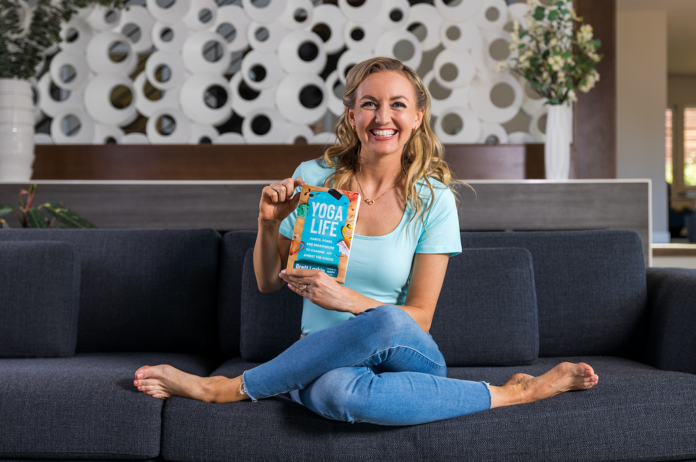Social Impact Authors: How & Why Author Brett Larkin of Uplifted Yoga Is Helping To Change Our World
Invest in yourself. I wish I’d invested in professional photos and advertising a lot earlier when I was just starting out.
As part of my series about “authors who are making an important social impact”, I had the pleasure of interviewing Brett Larkin.
Brett Larkin is the founder of Uplifted Yoga® and the author of Yoga Life: Habits, Poses, and Breathwork to Channel Joy Amidst the Chaos. Her Online Yoga Teacher Trainings have set the standard for quality online certification since 2015 and matriculated thousands of yoga teachers. Brett’s award-winning YouTube channel with over half a million subscribers and Uplifted Yoga Podcast empower you to actively design your life using yoga’s ancient wisdom. Yoga enthusiasts love her courses on Kundalini Yoga, Prenatal Yoga, and the Uplifted Yoga® Academy. Learn more at BrettLarkin.com.
Can you tell us a bit about your childhood backstory?
Growing up, I loved storytelling, playing make-believe, and singing. I always wanted to be a writer, and as an adult, I realized this really meant I wanted to craft experiences for people.
As a kid, I would write little stories and I loved filming videos. My father really instilled an entrepreneurial spirit into me. During the age of floppy disks, he helped me type my first story on a computer and print it, which felt so empowering as a little kid.
When I was a bit older, around age nine, he bought me a camcorder. I started filming stop motion videos of my troll dolls. A few years later, at age eleven, he helped me build a website about my favorite TV show at the time (Sabrina the Teenage Witch, of course).
I also used to go out into this big field at my dad’s house and sing, which has funnily enough translated into my work now, as I’ve started producing my own music and chanting tracks for my courses.
When you were younger, was there a book that you read that inspired you to take action or changed your life? Can you share a story about that?
I was a big fan of the Babysitter’s Club series. The babysitters were like the original girl bosses — young teens who were taking action to deal with different issues in their lives. I loved the idea of running a group and being a leader, like Kristy, the founder of the club.
I think reading about a fictional character who had a strong sense of leadership and an entrepreneurial spirit left an impression on me and made me realize that maybe one day I could create and lead something too.
It has been said that our mistakes can be our greatest teachers. Can you share a story about the funniest mistake you made when you were first starting? Can you tell us what lesson you learned from that?
I’ve had so many “failures” — but at the end of the day, I’m more grateful for them than anything else, because that’s when I’ve learned the most! I’ll never forget the time I was hired to lead a yoga class in a fancy corporate setting. I spent so much time prepping and I created this really long, advanced sequence that I thought would blow the socks off these high-achieving, successful people. But when I showed up, it turned out the class was for a bunch of business dudes who couldn’t even sit cross-legged on the floor. I had to totally re-work everything on the fly. At one point, I told everyone to lengthen their tailbone. Someone yelled from the back of the class, “What’s your tailbone?!” I knew I’d really need to get creative after that.
Since then, I’ve failed many times, but I’ve never let failure stop me. I have no shortage of ideas, and I just kept trying them, sticking with the ones that work and letting go of the ones that don’t.
Can you describe how you aim to make a significant social impact with your book?
I want to teach people that yoga was always meant to be personalized. The way yoga spread to the West was in a very structured fashion — with a generalized, methodical approach. However, that type of yoga was designed for monks in an ashram, not busy people living in the modern world.
I want to take yoga outside the studio and teach people to personalize their practice so it fits into their everyday life (not fitting their life into a yoga studio schedule).
Linking breath and movement (a.k.a. yoga) can happen anywhere, anytime. I want to empower people to become their own yoga teacher, instead of feeling like they have to learn from a guru. Unless you’re reading this in an ashram, and have eight hours a day to meditate your way to enlightenment, you need a different kind of yoga. A yoga that is designed for busy people with real-world commitments, kids, dogs, and clutter in their garage. That’s what my book aims to teach people, how to bring ancient yogic wisdom to every area of their life, on and off the mat.
Can you share with us the most interesting story that you shared in your book?
The core message is “less is more” — which is the opposite of what society tells us. We think we need a studio, a new wardrobe, and 90 minutes to practice yoga, but we really only need a floor and 90 seconds. It’s possible to feel great (even better) in 20 minute personal practice than in a 90 minute studio class. The key is finding your soulmate poses that match your unique personality and energy type. Once you do that, you can pop into a yoga pose in the kitchen while you’re waiting for your tea water to boil or in the bathroom as you wait for the tub to fill. Even 3 minutes of yoga helps your sanity.
What was the “aha moment” or series of events that made you decide to bring your message to the greater world? Can you share a story about that?
A few years ago, I hit a rock bottom when I was the sole caregiver for my father during his life-ending battle with cancer, a first-time mom caring for my newborn son, and also managing the explosive growth of my business, all after moving to another state where I knew no one and had no support network. At the time, I felt like a fraud because I could barely make it to the mat most days, let alone show up to my favorite 60 minute studio class.
Then, one horrific night while sobs and suffering echoed from every room of my apartment, I had an epiphany: What had to change wasn’t my commitment to yoga, it was the yoga itself. I needed a new kind of practice that could keep me afloat when I was drowning.
I started doing a 20 minute at-home practice that was personalized to me that made me feel just as good as a 90 minute studio class. By changing my yoga practice in a time of crisis, I realized this transformation was actually better and more realistic for living in this modern world. I wanted other people to have this kind of yoga in their life too.
Without sharing specific names, can you tell us a story about a particular individual who was impacted or helped by your cause?
I had a yoga teacher training student who was dealing with multiple injuries and chronic conditions, which were preventing her from her passion of hiking. At a certain point, she couldn’t even get up and down the stairs. But yoga helped her turn it all around. At 40 years old, she took her first yoga class and fell in love.
Yoga gave her confidence in her physical body that she hadn’t had in decades. Flash forward ten years, she signed up for her first Uplifted Yoga Teacher Training, became a leader in our Uplifted Teacher Training world, got certified as a Mindful Outdoor Guide, is teaching multiple classes at two YMCAs, and wrote a book about mindfulness and nature.
Are there three things the community/society/politicians can do to help you address the root of the problem you are trying to solve?
I’m trying to help people fit yoga into the in between moments of their busy lives. But obviously, what would help even more is for people to have the proper time to take care of themselves, and that means advocating for better access to healthcare, paid parental leave, and a living minimum wage.
How do you define “Leadership”? Can you explain what you mean or give an example?
The leaders I look up to have excellent boundaries. They know what is a yes and what is a no. They’re embodied in themselves, meaning they’re secure in both what they desire and what they’re devoted to. They are in touch with what they really want and they take devoted action to reach those goals. To me, leadership is finding that balance between desire and devotion — between dreaming up a big vision and taking the day-to-day steps to achieve it.

What are your “5 things I wish someone told me when I first started” and why? Please share a story or example for each.
- Put up a picture of yourself as a kid by your desk. Look at them for every business decision. Ask: What would she do?
- Invest in yourself. I wish I’d invested in professional photos and advertising a lot earlier when I was just starting out.
- If you have an idea for something, there’s a reason to go for it. You’re a part of nature, and if the idea comes to you, it’s for a reason.
- Revenue is a lagging indicator in business. A lot of times, your investments take a long time to pay off.
- If there’s no controversy in what you’re sharing, your message isn’t strong enough. You should repel people, as well as attract them.
Can you please give us your favorite “Life Lesson Quote”? Can you share how that was relevant to you in your life?
My dad once told me: Life is a marathon, not a sprint. This advice really stuck with me, as I evolved my yoga practice, my business, and my family. Learning your own style and way of moving is harder and takes longer, but it actually saves so much time in the long-term. Once you know what works for you, on and off the mat, you can show up as your best self in all areas of life.
Is there a person in the world, or in the US, with whom you would like to have a private breakfast or lunch with, and why?
I’m a history nerd, so I can think of a few historical people I’d like to sit down and have a chat with. I’d love to meet with Patanjali, and ask him why he snuck Sutra 2.1 into his famous Yoga Sutras. Or to pick Indra Devi’s brain about what it was like to be the first female teacher of yoga as exercise.
How can our readers further follow your work online?
Read my book, Yoga Life: Habits, Poses, and Breathwork to Channel Joy Amidst the Chaos, browse my blog, or try my free Master the Basics training and guide. You can also connect with me on Instagram: @larkinyogatv
This was very meaningful, thank you so much. We wish you only continued success on your great work!
Social Impact Authors: How & Why Author Brett Larkin of Uplifted Yoga Is Helping To Change Our… was originally published in Authority Magazine on Medium, where people are continuing the conversation by highlighting and responding to this story.


